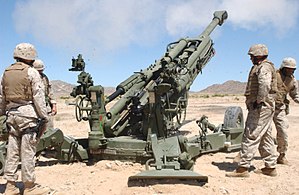
Back Artillerie Afrikaans Artillería AN مدفعية Arabic Artillería AST Artilleriya Azerbaijani Артылерыя Byelorussian Артылерыя BE-X-OLD Артилерия Bulgarian তোপ Bengali/Bangla Artiljerija BS
This article needs additional citations for verification. (June 2022) |

| Part of a series on |
| War (outline) |
|---|
 |
Artillery are ranged weapons that launch munitions far beyond the range and power of infantry firearms. Early artillery development focused on the ability to breach defensive walls and fortifications during sieges, and led to heavy, fairly immobile siege engines. As technology improved, lighter, more mobile field artillery cannons developed for battlefield use. This development continues today; modern self-propelled artillery vehicles are highly mobile weapons of great versatility generally providing the largest share of an army's total firepower.
Originally, the word "artillery" referred to any group of soldiers primarily armed with some form of manufactured weapon or armour. Since the introduction of gunpowder and cannon, "artillery" has largely meant cannon, and in contemporary usage, usually refers to shell-firing guns, howitzers, and mortars (collectively called barrel artillery, cannon artillery or gun artillery) and rocket artillery. In common speech, the word "artillery" is often used to refer to individual devices, along with their accessories and fittings, although these assemblages are more properly called "equipment". However, there is no generally recognized generic term for a gun, howitzer, mortar, and so forth: the United States uses "artillery piece", but most English-speaking armies use "gun" and "mortar". The projectiles fired are typically either "shot" (if solid) or "shell" (if not solid). Historically, variants of solid shot including canister, chain shot and grapeshot were also used. "Shell" is a widely used generic term for a projectile, which is a component of munitions.
By association, artillery may also refer to the arm of service that customarily operates such engines. In some armies, the artillery arm has operated field, coastal, anti-aircraft, and anti-tank artillery; in others these have been separate arms, and with some nations coastal has been a naval or marine responsibility.
In the 20th century, target acquisition devices (such as radar) and techniques (such as sound ranging and flash spotting) emerged, primarily for artillery. These are usually utilized by one or more of the artillery arms. The widespread adoption of indirect fire in the early 20th century introduced the need for specialist data for field artillery, notably survey and meteorological, and in some armies, provision of these are the responsibility of the artillery arm. The majority of combat deaths in the Napoleonic Wars, World War I, and World War II were caused by artillery.[1] In 1944, Joseph Stalin said in a speech that artillery was "the god of war".[1]
- ^ a b Bellamy, Christopher (2004). "artillery". Oxford Companion to Military History. Oxford University Press. ISBN 978-0-19-860696-3.